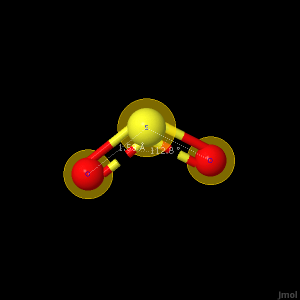Models of SO2 were made using the best ab initio level of theory, which was 321G. This is the best level of theory because it ran the cleanest calculations for our molecule.
Bond lengths of SO2 were found using the ab initio levels. Atom 1(S) 2(O) and 3(O) in degrees.
| Level
of Theory |
Atoms
|
Bond
Length |
| 321G |
1-
2 |
1.5260
Å |
| 1-
3 |
1.5260
Å |
|
| 631G |
1-
2 |
1.5547
Å |
| 1-
3 |
1.5346
Å |
|
| DZV |
1-
2 |
1.5340
Å |
| 1-
3 |
1.5340
Å |
Below is an interactive SO2 under DZV theory.
|
|
The experimental value for SO2 is 2.443 Å.1
Below is a representation of sulfur dioxide's electrostatic potential. Of special note is the tendency of the electrons, shown as red hue, to localize near the oxygen, lending a polar character to this molecule.
|
|
The HOMO orbital is the highest energy molecular orbital occupied by electrons. From the model, it is seen that the HOMO orbital of Br2 is non-bonding, and from this model a person can predict how a molecule will react. Following SO2HOMO is, naturally, SO2LUMO. The LUMO can be seen to involve the sulfur atom, whereas the HOMO is a bond shared between the oxygens.
|
|
|
|
Vibrational Frequencies
The extra noise around 2600 cm-1 - 2300cm-1 on the IR spectrum is due to carbon monoxide and air.
Click Below to see the motion of the molecule at the frequency 454 cm-1. This contributes to the ~517.7 cm-1 in the IR Spectrum.
|
|
Click below to see the motion of the molecule at the frequency 1032 cm-1. This contributes to ~1151.4 cm-1 peak in the IR spectrum.
|
|
Click below to see the motion of the molecule at the frequency 1143 cm-1. This contributes to the ~1361.8 cm-1 peak in the IR spectrum.
|
|
The dipole moments for SO2 at each level of theory.
| Level
of
Theory |
Dipole
Moment |
| 321G |
3.382
Debye |
| 631G |
3.203
Debye |
| DZV
|
3.422
Debye
|
The experimental value was found to be 1.630 Debye.1
The mulliken population for the SO2 molecule.
| Atom |
Mulliken |
| S |
1.33 |
| O
(2) |
-0.6655 |
| O
(3) |
-0.6655 |
More imformation on Sulfur Dioxide can be found through the NIST website.
Reference
(1) U.S. Secretary of Commerce, Computational Chemistry Comparison and Benchmark
DataBase, on behalf of the United States of America, 2010. Website: <http://cccbdb.nist.gov/>
Page skeleton
and JavaScript generated by export to web function using Jmol 11.8.20 2010-02-28 19:28
on Mar 24, 2010.
